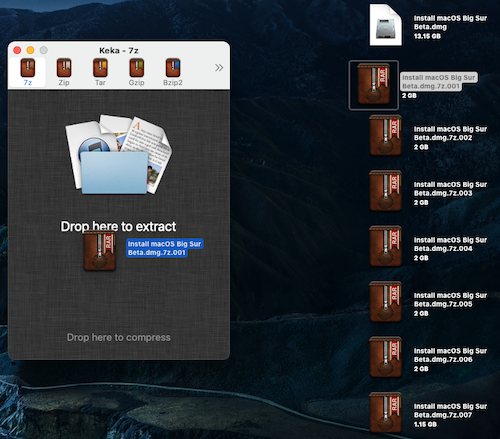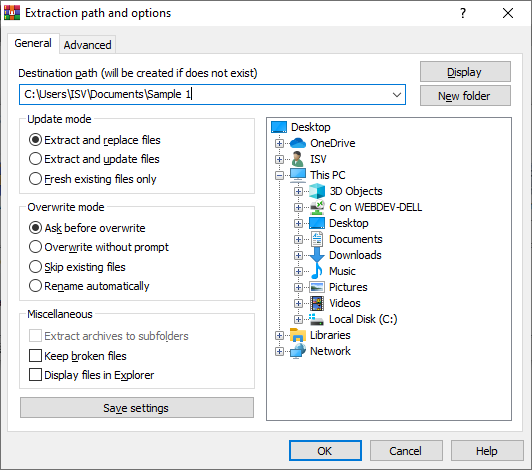Macos Extract 7z
7z x test.zip -aoa 7z: use the 7-zip executable x: use the extract command test.zip: extract files from this archive -aoa: overwrite all existing files Multiple files. To add many files to one archive, please use the 'a' command and the wildcard. symbol. 7z Command Tutorial With Examples To Compress And Extract Files In Linux by İsmail Baydan 7zip is a popular tool and compression format. 7zip supports a wide range of platforms and operations systems like Windows, Linux, BSD, macOS, etc.
- To do this run 7z e -txar InstallAssistant.pkg '.dmg' This should give you the SharedSupport.dmg file. You’ll need to extract Basesystem.dmg from SharedSupport.dmg. First run 7z e -tdmg SharedSupport.dmg 5.hfs. Next create a folder called stuff with mkdir stuff and mount the hfs filesystem to the stuff folder with sudo mount -oloop.
- I was late to the CC party and experienced this as the built in Archive Utility in macOS can’t handle 7z files. The best tool I have found to extract 7z and rar files is The Unarchiver and you can download it straight from the Mac App Store here. It’s really simple to use as it sets itself up as the default unarchiver on your Mac so once.

UPDATE: Back in August 2020 I showed you how to install macOS Big Sur with OpenCore on Linux. Back then Big Sur was in beta and you had to take some extra steps to install it. Now, that Big Sur is out of beta, the installation process was simplified and I’ve decided to create a new tutorial instead of editing the old one, to avoid any confusion. Let’s get started…
Inkscape is a useful program with open-source code, which you can use instead of Corel DRAW X5 crack. The toolset is a mixture of basic instruments and those aimed at more interesting tasks – a spiral tool for creating templates and clone arrangements, profound options for manipulating objects, and different filters. Corel draw crack for mac.
If you’re running a Linux distro as your daily driver, you can still other distros and OS’. You can even enjoy macOS. You can run Catalina using the clover bootloader and you can even install macOS in a Docker container.
Today we’re going to take a look at how set up a simple macOS Big Sur VM in QEMU, accelerated by KVM.
ALSO READHOW TO: Dual Boot macOS and Linux
REQUIREMENTS
- A modern Linux distribution
- QEMU > 2.11.1
- A CPU with Intel VT-x / AMD SVM support is required
- A CPU with SSE4.1 support is required for >= macOS Sierra
- A CPU with AVX2 support is required for >= macOS Mojave
- Internet access for the installation process
INSTALL QEMU & OTHER REQUIRED PACKAGES
Open the terminal and run: sudo apt install qemu uml-utilities virt-manager dmg2img git wget libguestfs-tools p7zip
NOTE: Adjust install command and, possibly, packages names according to your distro.
INSTALL macOS Big Sur
1. Open the terminal and run git clone --depth 1 https://github.com/kholia/OSX-KVM.git macOS-Big-Sur. When you’re done cloning the git repo, cd into path with cd macOS-Big-Sur
2. Download macOS Big Sur installer from Apple with ./fetch-macOS.py.
NOTE: Here you can choose which macOS you want to install. We will install Big Sur.
When the download is done, you should have InstallAssistan.pkg in your folder.
3. Now we need to unpack the downloaded InstallAssistan.pkg. To do this run 7z e -txar InstallAssistant.pkg '*.dmg'
This should give you the SharedSupport.dmg file
4. You’ll need to extract Basesystem.dmg from SharedSupport.dmg. First run 7z e -tdmg SharedSupport.dmg 5.hfs
Next create a folder called stuff with mkdir stuff and mount the hfs filesystem to the stuff folder with sudo mount -oloop *.hfs stuff
Inside the stuff/com_apple_MobileAsset_MacSoftwareUpdate folder, there’s a .zip file.
Run 7z l stuff/com_apple_MobileAsset_MacSoftwareUpdate/*.zip to list the contents of the .zip file with and you will see it contains the Basesystem.dmg that we need.
5. Copy the .zip file to your Desktop with cp stuff/*MacSoftwareUpdate/*.zip ~/Desktop
Extract Basesystem.dmg located inside the zip file on your Desktop > AssetData > Restore
Now move the Basesystem.dmg back to your macOS Big Sur folder and you can unmount the stuff folder created earlier with sudo umount stuff.
6. Convert BaseSystem.dmg to BaseSystem.img with qemu-img convert BaseSystem.dmg -O raw BaseSystem.img
7. Create a virtual HDD image where macOS will be installed. Run qemu-img create -f qcow2 mac_hdd_ng.img 128G
NOTE: You can change the size of the virtual drive. 128 GB is just an example. Also if, for any reason, you want to change the name of the disk image from mac_hdd.img to something else, you’ll also have to update OpenCore-BS.sh to point to the new image name.
8. Now we can start the installation. But before we do, let’s edit the OpenCore-Boot.sh and add more RAM ( by default it’s set to use 3 gigs of RAM ). 8 gigs should be enough. At least Apple seems to think so.
You can do that with your favorite GUI text editor or from the terminal with nano, micro or vim.
9. Now you can start the installation process. Run ./OpenCore-BS.sh .
10. You’ll be greeted by this screen. Choose macOS Base System
Macos Open 7z
10. First thing you’ll need to do is run Disk Utility and format your virtual drive.
11. Exit Disk Utility, choose Reinstall macOS and go through the usual installation steps.
12. During the installation process, your virtual machine will restart and will boot back up. When it does, choose macOS Installer to continue the installation.
13. After a loong time of installing, you will eventually be able to boot into your macOS installation.
You will be greeted with the welcome screen where you can set up your account and settings.
Don’t expect this to run just like a Mac. It’s a VM afterall. And it will feel sluggish mainly because there’s a lack of hardware acceleration. This can only be fixed by passing through a graphics card to the VM. To learn how to do that and other tips, and troubleshooting check out the official project on Github.
7zip is a popular tool and compression format. 7zip supports a wide range of platforms and operations systems like Windows, Linux, BSD, macOS, etc.
Syntax
We will use following syntax for 7z command.
Help
First before starting using the 7z command we can get usage and help information by using -h option. We can see that different options like adding file to archive, benchmark, delete files from archive etc. listed with the -h option output.
Dmg usb bootable mac. Alternatively, we can list usage and help information without providing any option to the 7z command like below.
7z Commands
While using 7z there is two-component as we can see in the syntax. Os x vmware image download. One of them is commands. Commands are used to specify the operations like:
a: Add files to archiveb: Benchmarkd: Delete files from archivee: Extract files from archive (without using directory names)h: Calculate hash values for filesi: Show information about supported formatsl: List contents of archivern: Rename files in archivet: Test integrity of archiveu: Update files to archivex: eXtract files with full paths
Switches
Switches are used to specify some minor options like create SFX archive, compress shared files, set output log level. Here are some of them
--: Stop switches parsing-ai[r[-|0]]{@listfile|!wildcard}: Include archives-ax[r[-|0]]{@listfile|!wildcard}: eXclude archives- –
ao{a|s|t|u}: set Overwrite mode -an: disable archive_name field
Compress Files and Folders
7z can compress files and folders. We will use a command to create a new archive. The new archive file name will be mybackup.7z and we will put files named a.out , body.txt and folder cups . Here the
Here while starting 7z applications show some information about the 7z application like build number, version, developer. And then provided files and folders are scanned and the scan result is printed like 56 folders, 1550 files, and a total 142 MB. After compression is completed new archive size is printed as 96 MB.
Add Files To The Archive
In previous example we have created the archive file. Some time we need to add new files to the existing archive file. In this situations we will use same a option to add files.

In this operation mybackup.7z archive file already exists. Some information about the file is printed like path, compression type, size, etc. Then a new file is added to the existing archive or compressed file named mybackup.7z .
Delete Files From Archive
Another useful operation is removing one or more files from an existing archive file. We will use d command with the file we want to delete. In this example, we want to remove the file named fruits.txt from the archive file mybackups.7z .

Extract Files From The Archive/Compressed File
How To Extract 7z
We can extract all files from an archive or compressed file by using x command or option. We will also provide the archive or compressed file. In this example, we will extract the mybackups.7z .
As we can see from the screenshot there are some existing files which will be overwritten. There question whether we want to overwrite, skip, rename, etc. We answer this as Always. After extraction, some statistical information like total folder count, file count size, compressed size is printed.
List Contents of Archive
We can also list files of an archive with l command. We will list all files of mybackup.7z archive.

Macos Extract 7z File
In the output, we can see that files and folders are listed. While listing information like date, time, attributes, size, and name are provided.
